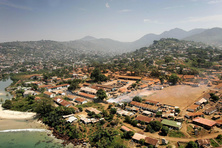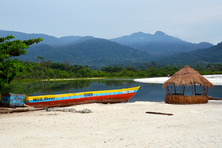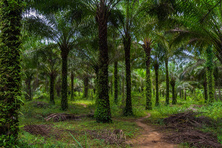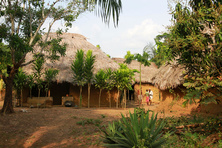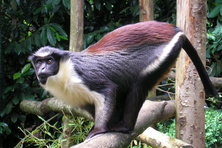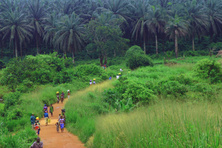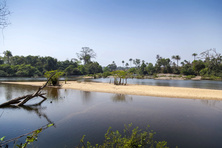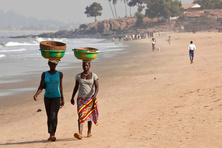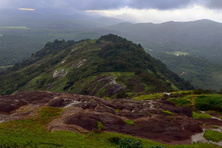Republic of Sierra Leone
- Currency: Sierra Leonean leone
- Time: UTC+0
- Languages: English
- Religions: Islam, Christianity, aboriginal cults
- Sections: Get in Visa Customs Cuisine Money Details of interest Popular resorts
The Republic of Sierra Leone is a West African state on the Atlantic coast. The capital city is Freetown. It borders Guinea and Liberia. The western and south-western part of Sierra Leone is washed by the Atlantic Ocean.
The climate in the country is equatorial. The annual average temperature is +27°C in April and +24°C in August. This country receives the most precipitation on the African continent. It is raining from May to September. And from November to May, northern winds are blowing whipping up dust and sand from the Sahara Desert. The best time for visiting Sierra Leone is in October and in winter.
The majority of the population practice local beliefs (52%) and 40% are the followers of Islam. The official language is English.
The lovers to spend time on a beach should go to the Banana Islands, the village John Obey in York, and Bureh Town. The resort Lakka is known for its wide beaches and ideal conditions for fishing.
If you prefer out-of-town holidays, visit the National Park Outamba-Kilimi in Kamakwie, the Forest Reserve Kaseve in Moyamba, the Cambui Hills Forest Reserve in Kenema, and the Mamunta Mayosso Wildlife Sanctuary in Yele. You will be impressed by the beauty of the Farangbaya Forest Reserve in Makeni and the Tiwai Island Wildlife Sanctuary, which is a habitat for 11 species of monkeys.
On the Bo plain close to the town with the same name the tourists can see typical animals of the African savannah. You can go hiking to the Bintumani Mount, the highest peak in Sierra Leone. On the lower slopes, crocodiles and pygmy hippopotamus live.
Go to Freetown for city entertainments and shopping.
Get in
By Plane
There are no direct flights between CIS countries and Sierra Leone. However, a flight still remains the fastest and the most convenient way to get to the country. BMI and British Airways offer transit flights to Freetown from CIS capitals with a transfer in London. Sierra National Airlines will get you from London to Freetown.
An alternative is to fly to Guinea with Air France from Paris and then Paramount Airlines will get you to Freetown.
Brussels Airlines offer the fastest routes.
By Land
There is a regular bus running between the capital city of Guinea Conakry and Freetown passing Cambui.
Visa
The tourists from Russian Federation, other CIS countries and EU must get a visa to travel to Sierra Leone.
There is an opportunity to apply for a visa online. The applicant will receive an entry permit to his or her e-mail and the sticker will be placed on arrival. To get a visa online go to the site of the Sierra Leone Ministry of Tourism, fill in the application form and attach the scan of your passport. The normal time for processing the documents is 3 days. A visa is valid for 3 months. This is a single entry visa for one month.
To travel to Sierra Leone you must have a yellow fever vaccination certificate.
Customs
According to the Money Laundering Law (2005), there are restrictions concerning the import and export of national and foreign currency. The import and export of the national currency is limited to 50.000 SLL. The tourists can import 10.000 US dollars and the money must be declared. The export of foreign currency is limited to the sum indicated on the declaration form.
The tourists are allowed to bring in the following goods duty-free:
- tobacco and alcohol;
- food and personal belongings.
Among others, it is prohibited to import:
- gold bars, plates, and scrap;
- gems and semi-precious stones (without permission of the Ministry of Finances of Sierra Leone).
Th following goods are subject to Customs control:
- ivory and leather goods;
- horns of animals;
- goods made of precious wood.
Be aware that Customs rules in Sierra Leone change quite often.
Cuisine
The traditional cuisine of Sierra Leone greatly depends on the natural conditions. The locals grow vegetables, fruits, and grains. The staple food in Sierra Leone is rice, manioc, yams, sorgo, cocoa, coffee, coconuts, bananas, and red palm oil. The local often add clove, cinnamon, and saffron to the dishes.
In Sierra Leone, they almost never cook meat, but when they do, they cook it with rice and peanuts. Goats, sheep, and cattle are used as currency but not as food. The most popular meat dish the tourists can try in Sierra Leone is Camun. It is a very exotic meat dish with dried fish, sweet potatoes, beans, chilli pepper, and red palm oil.
As there are many rivers and due to the closeness to the Atlantic Ocean, the local cuisine is rich in fish and seafood. In the restaurants in the capital city, the tourists can offer lobsters, prawns, turtles and many various fishes. We recommend a Sierra Leone soup with air-dried fish, meat, pumpkin, and spices.
Traditional vegetable dishes are roasted roots and bananas. Manioc is the main ingredient in many dishes. The locals commonly mash the leaves of manioc in a mortar and add the paste to vegetables, fish or meat.
Those who have a sweet tooth can treat themselves to an exotic dessert Canja (rice flour pastry with peanut and cane sugar) and banana fritters.
The most popular refreshing drinks are juices and cocoa-based beverages. The locals love ginger beer, but the traditional alcoholic drink is palm wine Pojo.
Money
The national currency in Sierra Leone is the Leone (SLL).
The tourists can exchange the currency only at banks.
Credit cards and traveller’s checks are not accepted. Only in large supermarkets and restaurants in Freetown Visa is accepted.
There are very few ATMs in Sierra Leone in Freetown, Bo, Keneme, Makeni, and Koidu.
Details of interest
Sightseeing in Sierra Leone
- Freetown is the capital city of Sierra Leone and one of the largest ports in West Africa. The main sight is the Thornton Fort. Some other touristic attractions are the Sierra Leone National Museum, St. George’s Cathedral, the Parliament House, and the Freetown Botanical Gardens. In the downtown, a Cotton Tree grows which is over 200 years old already. The tourists can go to the Jimmy King Market, which is the oldest market in the country. The Portuguese staircase built in the 15th century is very impressive and it is an important historical monument. The slaves went down the stairs to the galleys.
- Take a trip to the Banana Islands, for example, Mes-Meh, Ricketts or Dublin. Mes-Meh is an uninhabited island and Ricketts and Dublin are linked by a stone connecting strip.
- Take a walk across the lower slopes of Bintumani covered with tropical forests with crocodiles, monkeys, and rare pygmy hippopotamus.
- In the Outamba-Kilimi National Park, the tourists will meet the Aborigines of the tribe Coco and see a reach fauna of the Park. The Park is a habitat for over 100 species of birds, warthogs, elephants, and rare antelopes.
- The Tiwai Island is the largest internal island in Sierra Leone situated on the Moa River. On the Island, there is a unique Biosphere Reserve. The island is covered with jungles and it is one of the main touristic attraction in Sierra Leone.
- If you come to Sierra Leone you should visit, at least, one of the national reserves such as Kaseve, Cambui Hills Forest Reserve, Farangbaya Forest Reserve, Tingi Hills or Kangary Hills. The Gola Rainforest National Park is part of the tropical forests of the Upper Guinean Forests. In the past, these forests covered the third part of West Africa.
Souvenirs in Sierra Leone
- Bright clothes of the local tribes, jewellery, textile, and blankets are sold in Bo.
- In Freetown, the tourists can buy tools of trade and wooden figurines.
- In Port Loko, you can buy African masks.
- Bags, belts, and wallets made out of ostrich, snake, and crocodile skin are sold in Yele.







